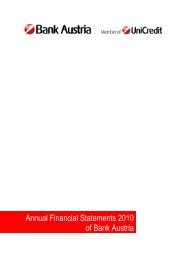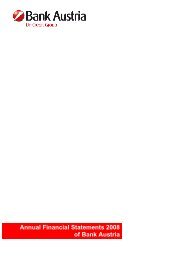Annual Financial Statements 2011 of Bank Austria
Annual Financial Statements 2011 of Bank Austria
Annual Financial Statements 2011 of Bank Austria
Create successful ePaper yourself
Turn your PDF publications into a flip-book with our unique Google optimized e-Paper software.
Management Report<br />
Management Report (CONTINUED)<br />
segments, and a gradual decrease <strong>of</strong> the impaired portion <strong>of</strong><br />
the portfolio. In Q4 <strong>2011</strong>, loans were made mainly to sectors<br />
such as wholesale trade, agriculture and transportation. There<br />
was a seasonal outflow <strong>of</strong> big ticket deposits in Q4 <strong>2011</strong> in<br />
large corporates mainly related to annual tax and dividend payments<br />
by clients. The retail segment experienced a significant<br />
increase <strong>of</strong> almost 10% in the deposit base in Q4 <strong>2011</strong>. Overall,<br />
the bank was able to increase customer deposits by about<br />
9% y/y. Net interest income grew by 18% q/q in Q3 <strong>2011</strong><br />
and by 7% y/y thanks to an increase in the loan books and to<br />
the further optimisation <strong>of</strong> the funding base. The increase in<br />
net fees and commissions in Q4 <strong>2011</strong> was generated mainly<br />
by the retail and Private <strong>Bank</strong>ing segments as a result <strong>of</strong> the<br />
enlarged client base and an improved range <strong>of</strong> products.<br />
Compared to the previous year, the bank increased revenue<br />
by more than 50% and lowered the cost <strong>of</strong> risk thanks to the<br />
improvement <strong>of</strong> asset quality.<br />
� In Q4 <strong>2011</strong>, the 3 Baltic countries (Estonia, Lithuania<br />
and Latvia), witnessed further signs <strong>of</strong> economic recovery.<br />
This was particularly the case in Estonia which has one <strong>of</strong><br />
Europe’s most dynamic GDP growth rates, driven mainly by<br />
buoyant exports. Estonia has been given the second highest rating<br />
in Eastern Europe by Standard & Poor’s (AA–). Lithuania was on<br />
track to post a strong and sustainable recovery in <strong>2011</strong> with<br />
impressive GDP growth in excess <strong>of</strong> 5%. Despite some slowdown<br />
in Q4 <strong>2011</strong>, the main indicators for consumption continue to show<br />
strong gains. Latvia’s GDP growth lags behind the other Baltic<br />
states but it is nonetheless strong and catching up. Inflation, as<br />
everywhere in the Baltics, remains at a fairly high level y/y on the<br />
back <strong>of</strong> energy and food prices.<br />
Net interest income <strong>of</strong> UniCredit <strong>Bank</strong> remained at a high level in<br />
Q4 <strong>2011</strong>, thus making a strong contribution to the full-year result;<br />
fee and commission income also contributed significantly to total<br />
revenues in Q4 <strong>2011</strong>, and also throughout <strong>2011</strong>. At the same<br />
time, the bank is continuing to pursue its tight cost discipline, with<br />
a positive impact on the cost/income ratio. After posting an operating<br />
loss in 2010, the bank achieved an operating pr<strong>of</strong>it in <strong>2011</strong><br />
and its performance improved significantly in <strong>2011</strong>. UniCredit<br />
<strong>Bank</strong> is well capitalised, with a capital adequacy ratio <strong>of</strong> close to<br />
13%. External funding was also raised via institutions such as the<br />
European Investment <strong>Bank</strong> and the Nordic Investment <strong>Bank</strong> for the<br />
purpose <strong>of</strong> diversifying funding sources.<br />
<strong>Bank</strong> <strong>Austria</strong> · <strong>Annual</strong> <strong>Financial</strong> <strong>Statements</strong> <strong>2011</strong><br />
47
















